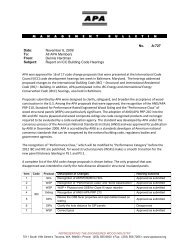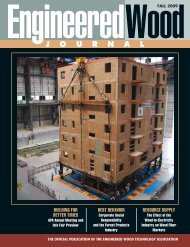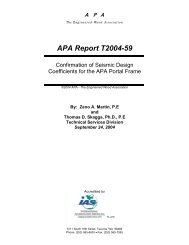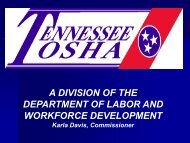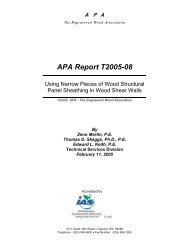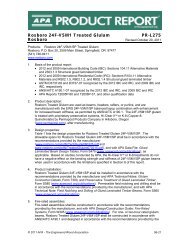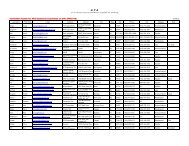Standard for Performance-Rated Engineered Cross-Laminated Timber
Standard for Performance-Rated Engineered Cross-Laminated Timber
Standard for Performance-Rated Engineered Cross-Laminated Timber
Create successful ePaper yourself
Turn your PDF publications into a flip-book with our unique Google optimized e-Paper software.
American National <strong>Standard</strong><br />
ANSI/APA PRG 320-201x<br />
<strong>Standard</strong> <strong>for</strong> Per<strong>for</strong>mance-<strong>Rated</strong><br />
<strong>Engineered</strong> <strong>Cross</strong>-<strong>Laminated</strong> <strong>Timber</strong><br />
APA – The <strong>Engineered</strong> Wood Association<br />
Pre-Draft: September 2010<br />
Approved xxxx xx, 201x<br />
American National <strong>Standard</strong>s Institute<br />
Pre-Draft <strong>Standard</strong> PRG-320 (September 2010) Page 1 of 13
Foreword (This Foreword is not a part of American National <strong>Standard</strong><br />
ANSI/APA PRG 320-201x)<br />
This <strong>Standard</strong> provides requirements and test methods <strong>for</strong> qualification and quality<br />
assurance <strong>for</strong> per<strong>for</strong>mance-rated engineered cross-laminated timber (CLT), which is<br />
manufactured from solid-sawn lumber intended <strong>for</strong> use in construction applications.<br />
Product per<strong>for</strong>mance classes are also specified.<br />
The development of this consensus American National <strong>Standard</strong> was achieved by<br />
following the Operating Procedures <strong>for</strong> Development of Consensus <strong>Standard</strong>s of APA –<br />
The <strong>Engineered</strong> Wood Association, approved by the American National <strong>Standard</strong>s<br />
Institute (ANSI).<br />
Inquires or suggestions <strong>for</strong> improvement of this <strong>Standard</strong> should be directed to APA –<br />
The <strong>Engineered</strong> Wood Association at 7011 South 19th Street, Tacoma, WA 98466,<br />
www.apawood.org.<br />
Pre-Draft <strong>Standard</strong> PRG-320 (September 2010) Page 2 of 13
1. Scope<br />
1.1 An engineered cross-laminated timber (CLT) is a rectangular-shaped, straight,<br />
and plane product manufactured from solid-sawn lumber manufactured specifically to<br />
meet the per<strong>for</strong>mance requirements of CLT in wood frame construction.<br />
1.2 Unless otherwise specified, the term “engineered cross-laminated timber”<br />
referenced in this standard represents the CLT products defined in Section 3.2.3 and<br />
qualified under this standard.<br />
1.3 This standard provides dimensions and tolerances, per<strong>for</strong>mance requirements,<br />
test methods, quality assurance, and trademarking <strong>for</strong> CLT.<br />
1.4 CLT shall be used in dry service conditions where the mean equilibrium moisture<br />
content of solid-sawn lumber is less than 16%.<br />
1.5 Products carrying a CLT trademark are to be used in accordance with the<br />
installation requirements prescribed in the code, if available, or product evaluation<br />
report, and the recommendations published by the CLT manufacturer, or its approved<br />
agency or trade association.<br />
1.6 The annex and discussion contained in this standard are mandatory, and notes<br />
and appendix are non-mandatory. This standard incorporates the U.S. customary units<br />
as well as the International System of Units (SI). The values given in the U.S. customary<br />
units are the standard and the SI values given in parentheses are <strong>for</strong> in<strong>for</strong>mation only.<br />
2. Referenced Documents<br />
This standard incorporates dated references. These normative references are cited at<br />
the appropriate places in the text. Subsequent amendments or revisions to these<br />
references apply to this standard only when incorporated into this standard by<br />
amendments or revisions.<br />
2.1 ASTM <strong>Standard</strong>s:<br />
D 9-09 <strong>Standard</strong> Terminology Relating to Wood and Wood-Based Products<br />
D 198-09 <strong>Standard</strong> Test Methods of Static Tests of Lumber in Structural Sizes<br />
D 1037-06a <strong>Standard</strong> Test Methods <strong>for</strong> Evaluating Properties of Wood-Base Fiber and<br />
Particle Panel Materials<br />
D 2395-07 <strong>Standard</strong> Test Methods <strong>for</strong> Specific Gravity of Wood and Wood-Base<br />
Materials<br />
D 2915-03 <strong>Standard</strong> Practice <strong>for</strong> Evaluating Allowable Properties <strong>for</strong> Grades of<br />
Structural Lumber<br />
D3501-05a <strong>Standard</strong> Test Methods <strong>for</strong> Wood-Based Structural Panels in Compression<br />
D 3737-08 <strong>Standard</strong> Practice <strong>for</strong> Establishing Stresses <strong>for</strong> Structural Glued <strong>Laminated</strong><br />
<strong>Timber</strong> (Glulam)<br />
D 4761-05 <strong>Standard</strong> Test Methods <strong>for</strong> Mechanical Properties of Lumber and Wood-<br />
Based Structural Material<br />
D 5456-09 <strong>Standard</strong> Specification <strong>for</strong> Evaluation of Structural Composite Lumber<br />
Products<br />
F 1667-05 <strong>Standard</strong> Specification <strong>for</strong> Driven Fasteners: Nails, Spikes, and Staples<br />
Pre-Draft <strong>Standard</strong> PRG-320 (September 2010) Page 3 of 13
2.2 Other <strong>Standard</strong>s:<br />
ANSI/AF&PA NDS-2005 National Design Specification <strong>for</strong> Wood Construction<br />
ANSI/AF&PA SDPWS-2008 Special Design Provisions <strong>for</strong> Wind and Seismic<br />
ANSI/AITC 405-2008 <strong>Standard</strong> <strong>for</strong> Adhesives <strong>for</strong> Use in Structural Glued <strong>Laminated</strong><br />
<strong>Timber</strong><br />
ANSI/AITC A190.1-2007 Structural Glued <strong>Laminated</strong> <strong>Timber</strong><br />
ANSI/ASME <strong>Standard</strong> B18.2.1-1996 Square and Hex Bolts and Screws (Inch Series)<br />
CSA B111-1974 (R2003) Wire Nails, Spikes and Staples<br />
CSA O86-09 Engineering Design in Wood<br />
CSA O112.10-08 Evaluation of Adhesives <strong>for</strong> Structural Wood Products (Limited<br />
Moisture Exposure)<br />
CSA O122-06 Structural Glued-<strong>Laminated</strong> <strong>Timber</strong><br />
US Product <strong>Standard</strong> PS 1-07 Structural Plywood<br />
3. Terminology<br />
3.1 Definitions: See the referenced documents <strong>for</strong> definitions of terms used in this<br />
standard.<br />
3.2 Description of terms specific to this standard:<br />
3.2.1 Approved Agency – An established and recognized agency regularly<br />
engaged in conducting tests or furnishing inspection services, when such agency has<br />
been approved by regulatory bodies (see Qualified Inspection Agency and Qualified<br />
Testing Agency).<br />
3.2.2 Characteristic Values – The structural property estimate, typically a<br />
population mean <strong>for</strong> stiffness properties or a tolerance limit (5 th percentile with 75%<br />
confidence) <strong>for</strong> strength properties, as estimated from the test data that is representative<br />
of the population being sampled.<br />
3.2.3 <strong>Cross</strong>-<strong>Laminated</strong> <strong>Timber</strong> (CLT) – A prefabricated solid engineered wood<br />
product made of at least three orthogonally bonded layers of solid-sawn lumber that are<br />
laminated by gluing of longitudinal and transverse layers to <strong>for</strong>m a solid rectangularshaped,<br />
straight, and plane timber intended <strong>for</strong> roof, floor, or wall applications.<br />
3.2.4 Edge Joints – Joints made by gluing of the edges of adjacent laminations<br />
within a CLT layer.<br />
3.2.5 End Joints – Joints made by gluing of the finger joints of the same<br />
laminations within a CLT layer.<br />
3.2.6 Layups – Arrangement of layers of timber of different species, grades, and<br />
thickness into a CLT product.<br />
3.2.7 Mill Specification -- A manufacturing specification based on product<br />
evaluation to be used <strong>for</strong> quality assurance purposes by the manufacturer and the<br />
approved agency.<br />
Pre-Draft <strong>Standard</strong> PRG-320 (September 2010) Page 4 of 13
3.2.8 Qualified Inspection Agency – An agency meeting the following<br />
requirements:<br />
(a) Has trained personnel to verify that the grading, measuring, species, construction,<br />
bonding, workmanship, and other characteristics of the products as determined by<br />
inspection comply with all applicable requirements specified in this standard,<br />
(b) Has procedures to be followed by its personnel in per<strong>for</strong>mance of the inspection,<br />
(c) Has no financial interest in, or is not financially dependent upon, any single company<br />
manufacturing the product being inspected,<br />
(d) Is not owned, operated, or controlled by any such company, and<br />
(e) Is accredited under ISO/IEC 17020.<br />
3.2.9 Qualified Inspection Agency – An agency meeting the following<br />
requirements:<br />
(a) Has access to the facilities and trained technical personnel to conduct testing on the<br />
characteristics of the products by sampling and testing in compliance with all<br />
applicable requirements specified in this standard,<br />
(b) Has procedures to be followed by its personnel in per<strong>for</strong>mance of the testing,<br />
(c) Has no financial interest in, or is not financially dependent upon, any single company<br />
manufacturing the product being tested,<br />
(d) Is not owned, operated, or controlled by any such company, and<br />
(e) Is accredited under ISO/IEC 17025.<br />
3.2.10 Structural Composite Lumber (SCL) – An engineered wood product that is<br />
intended <strong>for</strong> structural use and bonded with adhesives, and meets the definition and<br />
requirements of ASTM D 5456.<br />
3.2.11 Structural Glued-<strong>Laminated</strong> <strong>Timber</strong> (glulam) – An engineered, stress rated<br />
product of a timber laminating plant comprising assemblies of specially selected and<br />
prepared wood laminations securely bonded together with adhesives, and meets the<br />
definition and requirements of ANSI/AITC A190.1 or CSA O122.<br />
4. Dimensions and Dimensional Tolerances<br />
4.1 The thickness of CLT shall not exceed 20 inches (508 mm).<br />
4.2 The thickness of the CLT shall not deviate from the target thickness by more than<br />
� 5/64 inch (2 mm) or 2% of the thickness, whichever is the greater.<br />
4.3 Dimensional tolerances - Dimension tolerances permitted at the time of<br />
manufacture <strong>for</strong> CLT shall be as follows:<br />
Thickness – Tolerances shall be xx.<br />
Width – Plus or minus 1/x inch (x mm), measured to 1/32 inch or 0.79 mm).<br />
Length – xxx<br />
5. Component Requirements<br />
5.1 Lumber<br />
5.1.1 Lumber species<br />
Pre-Draft <strong>Standard</strong> PRG-320 (September 2010) Page 5 of 13
Any softwood lumber species recognized by American Lumber <strong>Standard</strong>s Committee<br />
(ALSC) or Canadian Lumber <strong>Standard</strong>s Accreditation Board (CLSAB) with a minimum<br />
published specific gravity of 0.42 may be used <strong>for</strong> CLT manufacturing provided that<br />
other requirements specified in this section are satisfied. Lumber specifies may be<br />
mixed within the same CLT product except at the same layer.<br />
5.1.2 Lumber grades<br />
For floor or roof applications, the minimum grade of lumber shall be 1650f-1.5E or<br />
visual grade No. 2 or better. For wall applications, the vertical layer shall be visual grade<br />
No. 2 or better and the horizontal layup shall be No. 3 or better. The top and bottom<br />
layers shall be the same lumber grade and thickness (balanced layup), while the inner<br />
layers are permitted to be of lower grade and thickness from top and bottom layers.<br />
5.1.3 Lumber sizes<br />
The net width of the lumber shall be 1-1/2 inches (38 mm) or wider. The thickness of<br />
the lumber shall not be less than 3/4 inch (19 mm) or more than 3-1/2 inches (89 mm).<br />
5.1.4 Moisture content<br />
The moisture content of the lumber at the time of the CLT manufacturing shall be 12<br />
± 2% with the variance within the same CLT of 4% maximum.<br />
5.1.5 Dimension tolerances<br />
The dimension tolerances <strong>for</strong> lumber shall be in accordance with the governing<br />
lumber grading rules with the exception that the thickness of the lumber shall not deviate<br />
by more than 1/xx inch (0.xx mm) within the same layer of lumber in a CLT product.<br />
5.2 Adhesives<br />
5.2.1 Adhesives used <strong>for</strong> CLT manufacturing shall meet all requirements of<br />
ANSI/AITC 405 in the U.S. and CSA O112.10 in Canada with the exceptions noted in<br />
this section.<br />
5.2.2 Section 2.1.6, durability based on either ASTM D 3434 or CSA O112.9, of<br />
ANSI/AITC 405 shall not be required.<br />
5.2.3 The Bunsen burner test specified in DOC PS1 shall be required.<br />
5.3 Lamination joints<br />
5.3.1 General<br />
The lamination joints of CLT shall meet the requirements specified in this section.<br />
5.3.2 Strength of End Joints in Laminations<br />
The strength of the end joints shall be tested in accordance with Section xx of<br />
ANSI/AITC A190.1 and meet the requirements specified therein.<br />
5.3.3 Strength of Edge Joints in Laminations<br />
The strength of the edge joints, when required, shall be tested in accordance with<br />
Section xx of ANSI/AITC A190.1 and meet the requirements specified therein.<br />
Pre-Draft <strong>Standard</strong> PRG-320 (September 2010) Page 6 of 13
5.3.4 Strength of Face Joints between Laminations<br />
5.3.4.1 The strength of the face joints between laminations shall be tested in<br />
accordance with Section xx of this standard and meet the requirements specified in this<br />
section.<br />
5.3.4.2 To Be Complete<br />
6. CLT Per<strong>for</strong>mance Criteria<br />
CLT shall meet the per<strong>for</strong>mance requirements established in this section.<br />
6.1 Layup requirements<br />
6.1.1 Layers made of laminations shall be orthogonally arranged and specified in<br />
the manufacturing standard of each CLT plant when qualified in accordance with the<br />
requirements specified in this section and recognized by an approved agency.<br />
6.2 Sampling<br />
6.2.1 Test samples shall be representative of typical production and shall be<br />
sampled at the manufacturing facility by an approved agency using the layup intended<br />
<strong>for</strong> qualification.<br />
6.2.2 The sample size required <strong>for</strong> stiffness capacities shall be sufficient <strong>for</strong><br />
estimating the population mean within 5% precision with 75% confidence, or 10<br />
specimens, whichever is greater. In general, a sample size larger than 10 is needed<br />
when the coefficient of variation is greater than 13%.<br />
6.2.3 The sample size required <strong>for</strong> strength capacities shall be sufficient <strong>for</strong><br />
estimating the characteristic value with 75% confidence in accordance with ASTM D<br />
2915.<br />
6.3 Structural Per<strong>for</strong>mance Requirements<br />
6.3.1 Structural per<strong>for</strong>mance shall be evaluated <strong>for</strong> each CLT layup unless<br />
otherwise noted in this section.<br />
6.3.2 CLT shall meet the minimum structural per<strong>for</strong>mance shown in Table 1 based<br />
on the test methods described in Section 7.<br />
Pre-Draft <strong>Standard</strong> PRG-320 (September 2010) Page 7 of 13
Table 1. Required Test Values (a) <strong>for</strong> CLT<br />
CLT Grades<br />
CLT-A1 (Floor or Roof)<br />
CLT-A2 (Floor or Roof)<br />
CLT-B1 (Wall)<br />
CLT-B2 (Wall)<br />
For SI: 1 in. = 25.4 mm, 1 lbf/ft = 0.0146 N/mm, 1 lbf = 4.448 N<br />
6.4 Durability Requirements<br />
To be complete<br />
6.4.1 Samples used <strong>for</strong> evaluating the durability of CLT shall be prepared from<br />
those products required in Section xx.<br />
6.4.2 Tests shall be conducted in accordance with the procedures provided in<br />
Section x.<br />
6.4.3 The mean durability shall be at least 75% of the mean capacity determined<br />
from Section 7.2.<br />
6.5 Physical Properties Requirements<br />
6.5.1 Samples used <strong>for</strong> establishing the physical properties of CLT shall be<br />
prepared from those products required in Section xx.<br />
7. Test Methods<br />
7.1 General<br />
7.1.1 Test methods provided in this section shall be used to establish the structural<br />
capacities of CLT.<br />
7.2 Test Method 1<br />
7.2.1 Specimen preparation<br />
7.2.2 Test procedures<br />
7.3 Test Method 2<br />
7.3.1 Specimen preparation<br />
7.3.2 Test procedures<br />
8. Product Evaluation<br />
8.1 Qualification Tests<br />
Pre-Draft <strong>Standard</strong> PRG-320 (September 2010) Page 8 of 13
Required qualification tests and criteria are detailed in Section 6 of this standard.<br />
Retesting shall be conducted using a new independent sample set.<br />
8.2 Mill Specification<br />
Upon con<strong>for</strong>mance with the requirements specified in this standard, a manufacturing<br />
specification unique to the product and mill shall be written based on product evaluation.<br />
This specification shall be used <strong>for</strong> quality assurance purposes by the manufacturer and<br />
the approved agency. Product evaluation will be accomplished on the same lot supplied<br />
by the manufacturer <strong>for</strong> qualification testing. Reference values shall be established<br />
during product evaluation or from applicable per<strong>for</strong>mance requirements in this standard,<br />
as specified in Section 9.<br />
8.3 Trademarking and Certification<br />
8.3.1 Certification<br />
All CLT products represented as being in con<strong>for</strong>mance with this standard shall bear the<br />
stamp of an approved agency which (1) either inspects the manufacture or (2) has<br />
tested a random sampling of the finished products in the shipment being certified <strong>for</strong><br />
con<strong>for</strong>mance with this standard.<br />
8.3.2 Product Marking<br />
All CLT products represented as con<strong>for</strong>ming to this standard shall be identified with<br />
marks giving the following in<strong>for</strong>mation:<br />
a) CLT Grade qualified in accordance with this standard.<br />
b) The CLT thickness<br />
c) The mill name or identification number<br />
d) The approved agency name or logo<br />
e) The symbol of “ANSI/APA PRG 320” signifying con<strong>for</strong>mance with this standard.<br />
f) Any manufacturer’s designations which shall be separated from the grade-marks or<br />
trademarks of the qualified agency by not less than 6 inches (152 mm).<br />
8.3.3 Voiding Marks<br />
CLT originally marked as con<strong>for</strong>ming to this standard but subsequently rejected as not<br />
con<strong>for</strong>ming thereto shall have any reference to the standard obliterated or voided by the<br />
manufacturer.<br />
Note: This can be per<strong>for</strong>med by blocking out the stamp with permanent black ink or light<br />
sanding.<br />
9. Quality Assurance<br />
9.1 Objective<br />
This section is intended <strong>for</strong> use with CLT that has qualified <strong>for</strong> trademarking under this<br />
standard. The purpose of this section is to assure product quality by detecting changes<br />
in properties which may adversely affect the CLT per<strong>for</strong>mance. In all cases, the criteria<br />
to which the CLT is tested will be provided in the Mill Specification.<br />
Pre-Draft <strong>Standard</strong> PRG-320 (September 2010) Page 9 of 13
9.2 Referenced <strong>Standard</strong>s<br />
9.2.1 CLT quality assurance requirements may be considered satisfied when the<br />
requirements <strong>for</strong> the referenced standards in Section 2 and any additional requirements<br />
listed in Section x are met.<br />
9.2.2 Referenced standards shall be specified by product type to define appropriate<br />
procedures and/or guidelines <strong>for</strong> quality assurance. If a product trademarked under this<br />
standard is trademarked under another standard, samples shall be taken <strong>for</strong> both<br />
standards.<br />
Pre-Draft <strong>Standard</strong> PRG-320 (September 2010) Page 10 of 13
Annex A. Design Properties <strong>for</strong> ANSI/APA PRG-320 CLT<br />
Table A1. Allowable Design Values <strong>for</strong> CLT<br />
Table A2. Limit States Design Values <strong>for</strong> CLT<br />
Pre-Draft <strong>Standard</strong> PRG-320 (September 2010) Page 11 of 13
Appendix A. History of <strong>Standard</strong> (Non-Mandatory)<br />
In March 2010, the APA <strong>Standard</strong>s Committee on <strong>Standard</strong> <strong>for</strong> Per<strong>for</strong>mance-<strong>Rated</strong><br />
<strong>Engineered</strong> <strong>Cross</strong>-<strong>Laminated</strong> <strong>Timber</strong> was <strong>for</strong>med to develop a national standard under<br />
the consensus processes accredited by the American National <strong>Standard</strong>s Institute<br />
(ANSI). This national consensus standard, designated as ANSI/APA PRG 320, is<br />
developed based on broad input from around the world.<br />
The names of the ANSI/APA PRG 320 Committee members when the standard is<br />
published are as follows. The current list of the committee membership is available from<br />
the committee secretariat upon request.<br />
Name Affiliation<br />
Inquiries or suggestions <strong>for</strong> improvement of this standard should be directed to:<br />
Secretariat, ANSI/APA PRG 320<br />
APA – The <strong>Engineered</strong> Wood Association<br />
7011 South 19 th Street<br />
Tacoma, WA 98466<br />
www.apawood.org<br />
Pre-Draft <strong>Standard</strong> PRG-320 (September 2010) Page 12 of 13
Appendix B. ASD-to-LSD Conversion Factors (Non-Mandatory)<br />
Pre-Draft <strong>Standard</strong> PRG-320 (September 2010) Page 13 of 13



